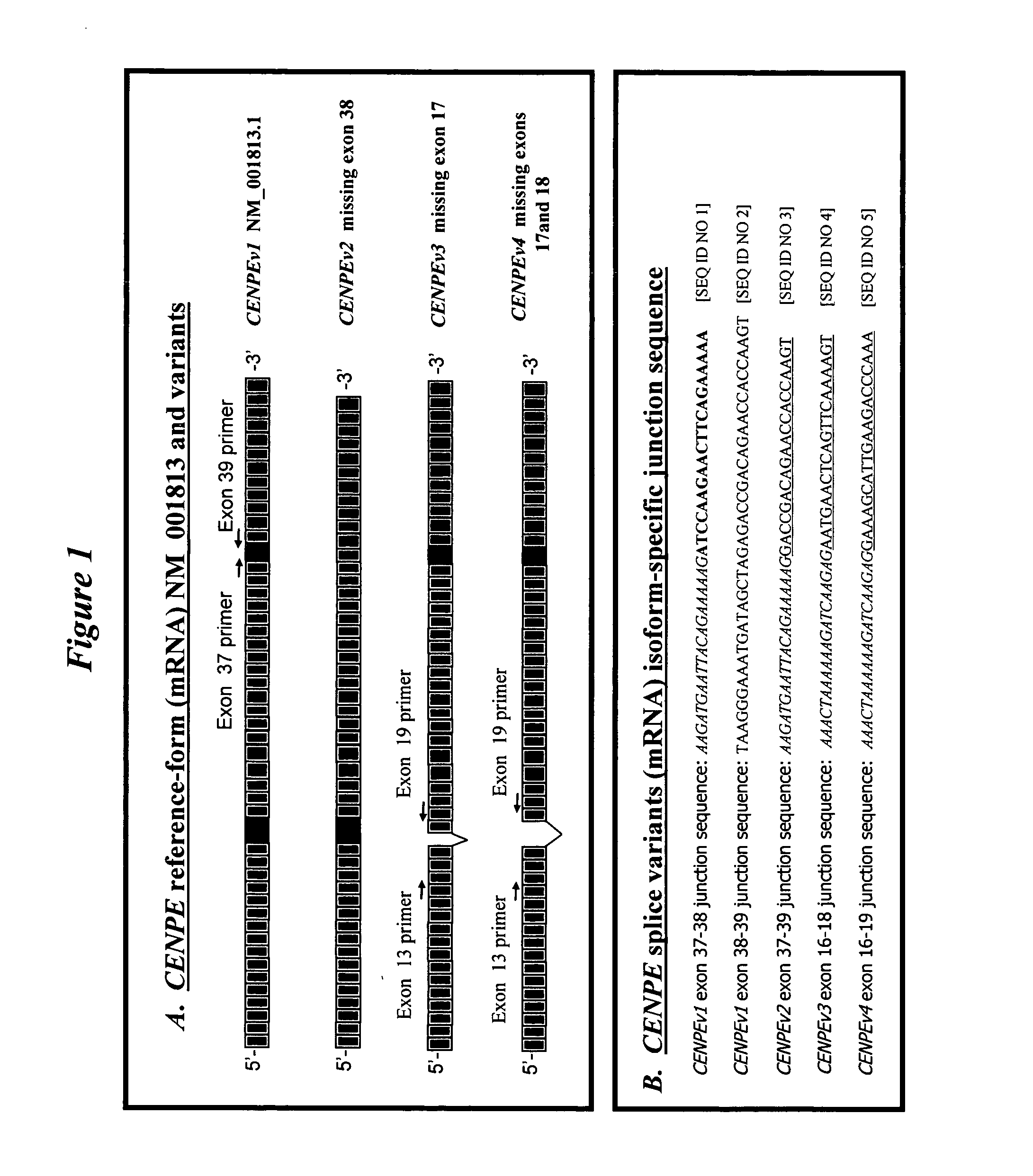Novel isoforms of centromere protein E (CENPE)
a technology of centromere protein and isoform, applied in the field of new isoforms of centromere protein e (cenpe), can solve the problem that the progression to anaphase cannot occur until certain requirements
- Summary
- Abstract
- Description
- Claims
- Application Information
AI Technical Summary
Benefits of technology
Problems solved by technology
Method used
Image
Examples
example 1
Identification of CENPEv2, CENPEv3, and CENPEv4 Using Microarrays
[0168] To identify variants in the splicing of the exon regions encoding CENPE, an exon junction microarray, comprising probes complementary to each splice junction resulting from splicing of the 50 exon coding sequences in CENPEv1 heteronuclear RNA (hnRNA), was hybridized to a mixture of labeled nucleic acid samples prepared from 44 different human tissue and cell line samples. Exon junction microarrays are described in PCT patent applications WO 02 / 18646 and WO 02 / 16650. Materials and methods for preparing hybridization samples from purified RNA, hybridizing a microarray, detecting hybridization signals, and data analysis are described in van't Veer, et al. (2002 Nature 415:530-536) and Hughes, et al. (2001 Nature Biotechnol. 19:342-7). Inspection of the exon junction microarray hybridization data (not shown) suggested that the structure of at least one of the exon junctions of CENPEv1 mRNA was altered in some of th...
example 2
Confirmation of CENPEv2 Using RT-PCR
[0169] The structure of CENPE mRNA in the region corresponding to CENPEv1 exons 37 to 39 was determined for a panel of human tissue and cell line samples using an RT-PCR based assay. PolyA purified mRNA isolated from 44 different human tissue and cell line samples was obtained from BD Biosciences Clontech (Palo Alto, Calif.), Biochain Institute, Inc. (Hayward, Calif.), and Ambion Inc. (Austin, Tex.). RT-PCR primers were selected that were complementary to sequences in exon 37 and exon 39 of the reference exon coding sequences in CENPEv1 (NM—001813.1). Based upon the nucleotide sequence of CENPEv1 mRNA, the CENPEv1 exon 37 and exon 39 primer set (hereafter CENPE37-39 primer set) was expected to amplify a 506 base pairs amplicon representing the “reference” CENPEv1 mRNA region. The CENPEv1 exon 37 forward primer has the sequence: 5′ CAACAGGAACTAAAAACTGCTC GTATGC 3′ [SEQ ID NO 20]; and the CENPEv1 exon 39 reverse primer has the sequence: 5′ AGGCTTTC...
example 3
Confirmation of CENPEv3 and CENPEv4 Using RT-PCR
[0182] The structure of CENPE mRNA in the region corresponding to exons 13 to 19 was determined for a panel of human tissue and cell line samples using an RT-PCR based assay.
[0183] PolyA purified mRNA isolated from 44 different human tissue and cell line samples was obtained from BD Biosciences Clontech (Palo Alto, Calif.), Biochain Institute, Inc. (Hayward, Calif.), and Ambion Inc. (Austin, Tex.). RT-PCR primers were selected that were complementary to sequences in exon 13 and exon 19 of the reference exon coding sequences in CENPEv1 (NM—001813.1). Based upon the nucleotide sequence of CENPEv1 mRNA, the CENPEv1 exon 13 and exon 19 primer set (hereafter CENPEv13-19 primer set) was expected to amplify a 740 base pairs amplicon representing the “reference” CENPEv1 mRNA region. The CENPEv1 exon 13 forward primer has the sequence: 5′ TAACACGGATGCTGGTGACCTCTTCTTC 3′ [SEQ ID NO 22]; and the CENPEv1 exon 19 reverse primer has the sequence: ...
PUM
| Property | Measurement | Unit |
|---|---|---|
| polarity | aaaaa | aaaaa |
| polar ejection forces | aaaaa | aaaaa |
| elongation | aaaaa | aaaaa |
Abstract
Description
Claims
Application Information
 Login to View More
Login to View More - R&D
- Intellectual Property
- Life Sciences
- Materials
- Tech Scout
- Unparalleled Data Quality
- Higher Quality Content
- 60% Fewer Hallucinations
Browse by: Latest US Patents, China's latest patents, Technical Efficacy Thesaurus, Application Domain, Technology Topic, Popular Technical Reports.
© 2025 PatSnap. All rights reserved.Legal|Privacy policy|Modern Slavery Act Transparency Statement|Sitemap|About US| Contact US: help@patsnap.com

